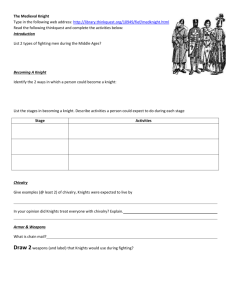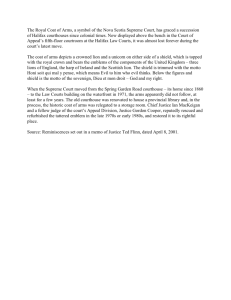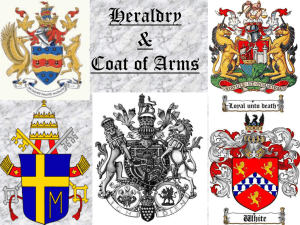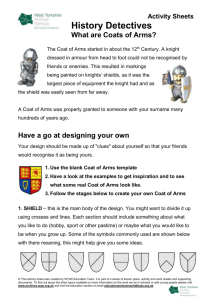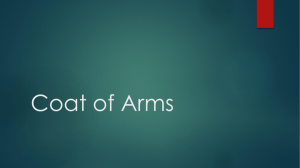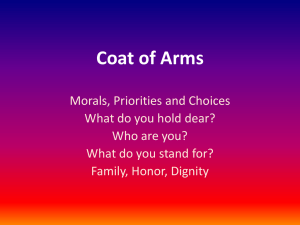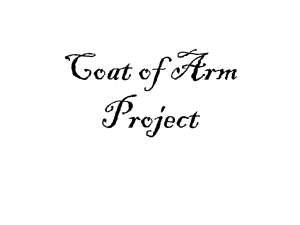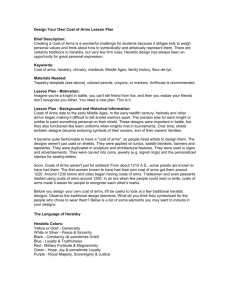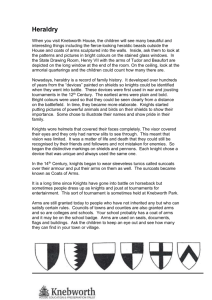Design Coat of Arms ppt
advertisement
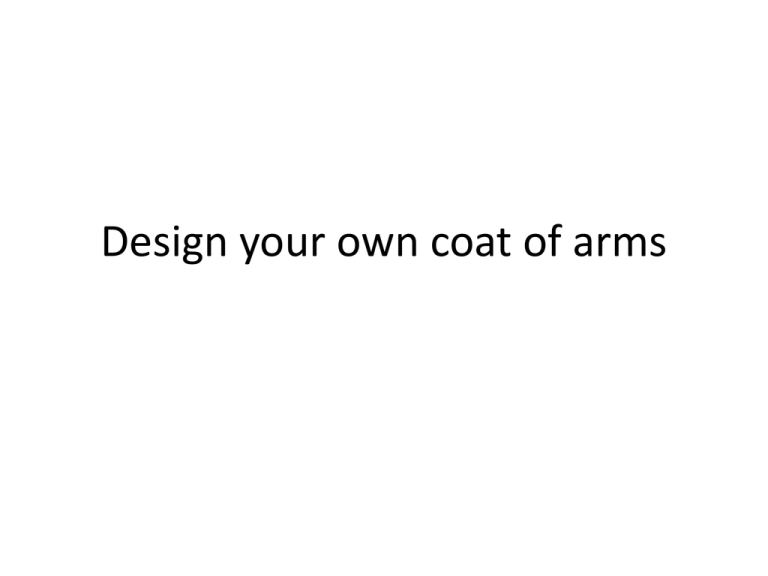
Design your own coat of arms Medieval Times • Medieval TimesMiddle Ages-Dark Ages, many terms have been used to describe this period spanning more than a thousand years. Church • The Church was very much in control of the gamut of medieval life. Technology • Civilization progressed slowly; science was looked upon with distrust and often, as heresy. Communications • Communication between and within countries was tedious and primarily sent word-ofmouth. Information • Books were a rarity, and writing was the province of the powerful. Art • Art and literature were on the decline, as the former marvels of Rome were swept away by time. Chivalry • Chivalry is the generic term for the knightly system of the Middle Ages and for virtues and qualities it inspired in its followers Chivalry • 13th Century conventions of chivalry directed that men should honor, serve, and do nothing to displease ladies and maidens. Knights • Knights were members of the noble class socially as bearers of arms, economically as owners of horse and armor, and officially through religious-oriented ceremony. What side are you on? • Coats of Arms date to the early Middle Ages. In the early twelfth century, helmets and other armor began making it difficult to tell armed warriors apart. Emblems • The solution was for each knight or soldier to paint something personal on their shield. These designs were important in battle, but they also functioned like team uniforms when knights met in tournaments. Knights in battle A brief History • Over time, shield emblem designs became enduring symbols of their owners, and of their owners' families. • It became quite fashionable to have a "coat of arms", so people hired artists to design them. The designs weren't just used on shields. They were applied on tunics, saddle blankets, banners and tapestries. A brief History • They were duplicated in sculpture and architectural features. They were used in signs and advertisements. They were carved into coins, jewelry (e.g. signet rings) and the personalized stamps for sealing letters. A brief History • Soon, Coats of Arms weren't just for soldiers! From about 1210 A.D., some priests are known to have had them. • The first women known to have had their own coat of arms got them around 1220. Around 1230 towns and cities began having coats of arms. Tradesmen and even peasants started using coats of arms around 1250. A brief History • In an era when few people could read or write, coats of arms made it easier for people to recognize each other's marks. • Before you design your own coat of arms, it'll be useful to look at a few traditional heraldic designs. Observe the traditional design elements. Heraldic Colors Yellow or Gold - Generosity White or Silver - Peace & Sincerity Black - Constancy (& sometimes Grief) Blue - Loyalty & Truthfulness Red - Military Fortitude & Magnanimity Green - Hope, Joy & sometimes Loyalty Purple - Royal Majesty, Sovereignty & Justice Heraldic Animals Bear - Protectiveness Bee - Industriousness Camel - Perseverance Dog - Loyalty Double Eagle & Eagle - Leadership & Decisiveness Dragon - Defender of Treasure Falcon or Hawk - Eagerness Fox - Cleverness Griffin (part eagle, part lion) - Bravery Horse - Readiness to Serve Lion - Courage Pelican - Generosity & Devotion Raven - Constancy Snake - Ambition Stag, Elk or Deer - Peace & Harmony Tiger - Fierceness & Valor Unicorn - Extreme courage Wolf - Constant Vigilance Heraldic Symbols Axe - Dutiful Bridge - (signifies a governor or magistrate) Crescent - Enlightenment Crosses - Christian sentiments Crown - Authority Fire - Zeal Flaming Heart - Passion Fleur-de-lys (stylized Iris flower) - Purity (associated with France) Hand - Faith, Sincerity & Justice Heart - Sincerity Horns & Antlers - Fortitude Lightning - Decisiveness Moon - Serenity Oyster Shell - Traveler Ring - Fidelity Scepter - Justice Star - Nobility Sun - Glory Sword - Warlike Tower or Castle - Fortitude & Protectiveness Common Design Features (heraldic terminology): Bend - a diagonal stipe Chevron - an upside-down "V" Chief - broad stripe across top of shield Dexter - the righthand side of the shield (from its user's perspective) Ermine - a white fur pattern (with black tail tips) Fess - broad horizontal stripe through center Pale - broad vertical stripe through center Passant - an animal shown walking Rampant - an animal standing on hind legs Sinister - the lefthand side of the shield (from its user's perspective) Other important design details: • Besides simple fields of color, a coat of arms may contain other design motifs, such as checkerboards, polka dots, or fur patterns. One traditional design rule is that two solidcolor fields shouldn't appear side by side unless one of the two is "metallic". • Even this "rule" has been broken by many famous and historical coats of arms. More Design Details • Few laws have ever been passed about the design of coats of arms, and even fewer of have ever been enforced! However, most European nations began requiring registration of coats of arms by the seventeenth century. • The registration requirements were somewhat like modern trademark laws - they were primarily intended to stop people from copying each other's designs. Coat of Arms components Examples Examples Objective • Create your own Coat of Arms • It should reflect who you are and what you stand for • Each person will present their Coat of Arms to the class and explain why you choose the objects to represent you • Your end product should be 1024X768 • Color or Black and White Resources • http://www.heraldryclipart.com/main.html • http://www.heraldicclipart.com/ • http://www.heraldry.ws/
